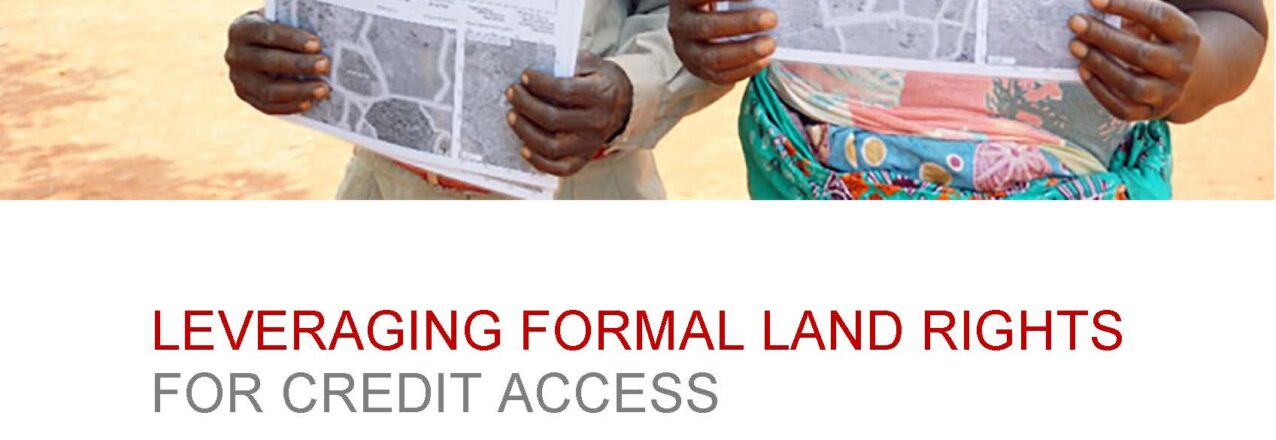Excerpt from the Report Introduction
Efforts by governments and donors to strengthen land rights by providing formal legal documentation to land users have a long history and continue to be common in many contexts. Both theory and evidence have identified several different channels by which formalizing land rights can result in economic benefits (Lisher 2019). These include strengthening incentives for land users to make investments on their land, reducing costs and risks associated with land conflicts resulting from weak definition or enforcement of rights, and enabling more efficient land distribution through land transactions.
One of the hypothesized pathways from formalization of land rights to economic benefits is through improved credit access for land users. The argument is that formalizing and documenting property rights can enable owners to offer their property as collateral when seeking loans. Collateral reduces the risks to financial institutions in event of default, and thus increases their willingness to lend. This pathway received widespread attention as a result of the Peruvian economist Hernando de Soto’s influential book The Mystery of Capital (2000). De Soto argued that formal property rights could catalyze development by unlocking the vast capital value of land and other assets held by the asset poor.
Evidence on the efficacy of the collateral mechanism in practice has been mixed. Formalization has been shown to have positive impacts on credit access by enabling collateral in some contexts. However, in other contexts formalizing land rights alone has been insufficient to enable land to be used as collateral or to overcome other barriers that constrain credit access, particularly for poorer landholders. One implication is that complementary programs or policies are needed to enable the collateral mechanism to work.
However, recently anecdotal evidence has begun to suggest that there may be alternative mechanisms whereby formalizing land rights can improve credit access, short of using land as collateral. Research findings and project-related anecdotal evidence identify a growing number of cases in which formalization has not enabled beneficiaries to use their land as collateral but has nonetheless led to improved credit outcomes. Some tentative explanations have been proposed, but to date there has not been an effort to bring this evidence together, and systematically identify what causal mechanisms are at work.
The research in this report is thus motivated by two related questions. First, what are the alternative mechanisms by which formalization can improve credit access? What do we know about these mechanisms in practice, and what are the implications for policy and programming? Secondly, what (if any) complementary programming and policy measures can help leverage these mechanisms to strengthen the impacts of formalization on access to credit, particularly for the poor? It is important to note that our intention is limited to identifying these mechanisms, how they may operate, and how they could inform future program design. We do not attempt to cover their efficacy as a means of improving credit access, as the evidence base on these mechanisms is too limited to draw conclusions from. This report and the evidence we review focuses on formal and semi-formal credit and the mechanisms through which land documents can improve access to formal and semi-formal credit. Formal and semi-formal credit includes loans provided by banking institutions, credit bureaus, microfinance institutions, donor-funded programs, and cooperatives and are subject to government regulations. We acknowledge that a majority of low-income rural dwellers borrow regularly from informal credit sources. The World Bank estimates that in developing countries about half the of those who took loans borrowed informally and primarily from families and friends (Demirguc-Kunt et al. 2017).
To address these questions, we combine a review and synthesis of the relevant literature with a set of Key Informant Interviews (KIIs) of development practitioners who have first-hand experience with these issues. Our objective is to identify lessons learned and provide actionable recommendations for policymakers and program designers to harness the benefits more fully to financial inclusion that can result from formalizing land rights.
Analysis seeks to understand how these alternative means work and under what circumstances, with the aim of informing future USAID programming so that formal land rights can be used to better facilitate access to financing by smallholders and the urban poor, especially women. Financial inclusion is in turn expected to result in improved investment, productivity, food security, and other welfare outcomes for those who are most vulnerable. Primary audiences for this research include USAID officers engaged in the design and oversight of programming on land tenure, agricultural development, food security, gender equity and women’s empowerment, and economic growth, together with their corresponding implementing partners.


